Effects of Land Use and Climate Change on Groundwater and Ecosystems at the Middle Reaches of the Tarim River Using the MIKE SHE Integrated Hydrological Model
Abstract
:1. Introduction
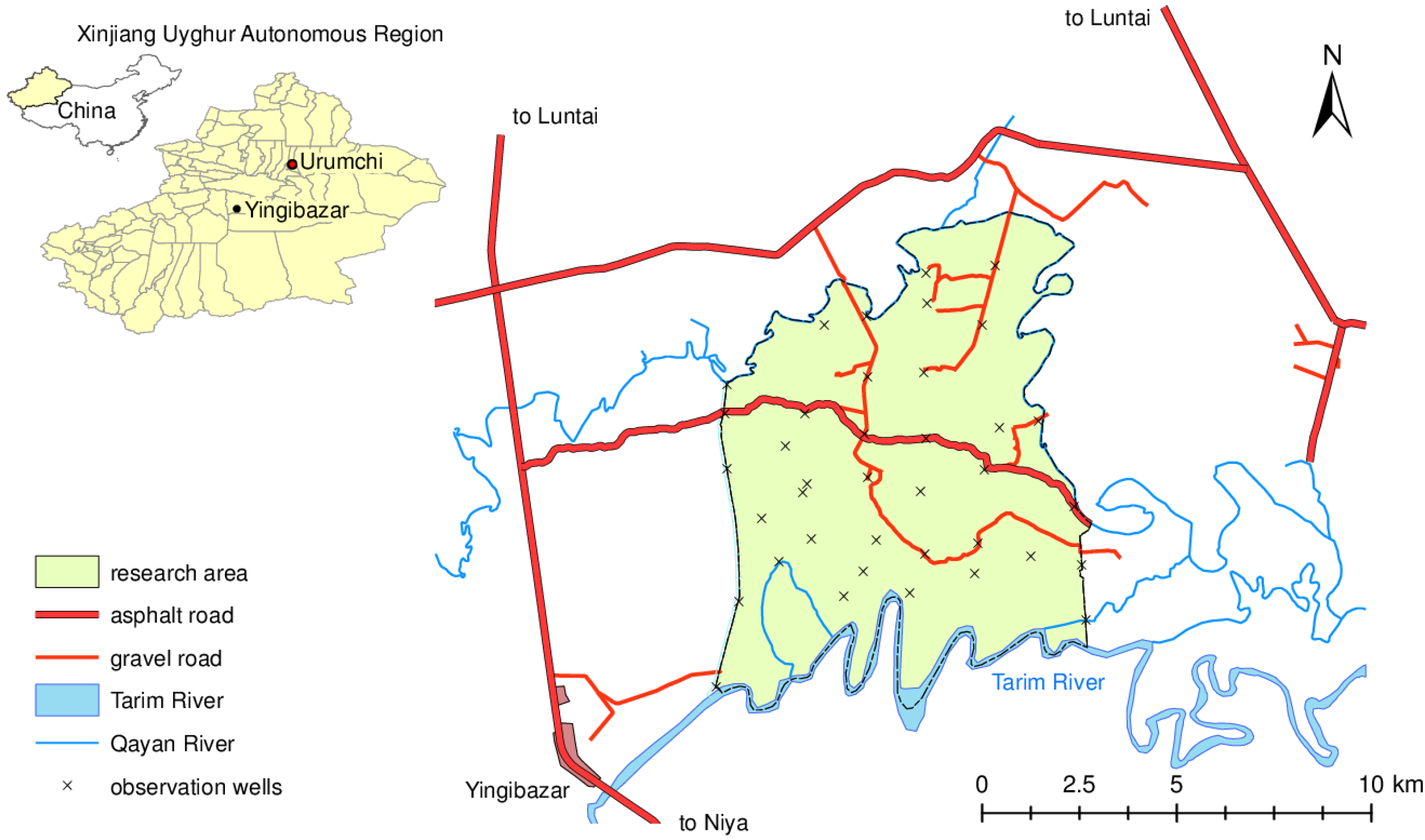
- -
- How do flooding at the floodplains, irrigation water from agriculture, and seepage losses from the Tarim River influence the groundwater recharge?
- -
- How do irrigation areas change the hydrologic balance and are there interactions between the bordering Tugai forests and irrigation areas?
- -
- What consequences can be expected as a result of changing land-use in the Tugai forests and/or climate change in the near and distant future?
2. Methodology
2.1. Data Processing
2.2. Model Setup

| Parameter | Value | Unit |
|---|---|---|
| 2D surface water | ||
| Resistance value (Manning number) | 15–35 | m1/3/s |
| Detention storage | 2 | mm |
| Initial water depth | 0 | m |
| Surface—subsurface leakage coefficient | 1 × 10−5 | 1/s |
| 1D surface water | ||
| Resistance value Tarim foreland & canals (Manning number) | 35 | m1/3/s |
| Resistance value Tarim riverbed (Manning number) | 45 | m1/3/s |
| Evapotranspiration | ||
| Canopy interception | 0.05 | mm × LAI |
| Kirstensen & Jensen parameter C1 | 0.3 | - |
| Kirstensen & Jensen parameter C2 | 0.2 | - |
| Kirstensen & Jensen parameter C3 | 20 | mm/d |
| Root distribution (Aroot) | 0.25 | 1/m |
| Unsaturated & saturated zone | ||
| Percolation | 1 × 10−12 | 1/s |
| Sand (S): kf *; np **; Sy ***; Ss **** | 713; 0.45; 0.33; 2.66 × 10−6 | cm/d; -; -; 1/m |
| Loamy sand (LS): kf; np; Sy; Ss | 124; 0.46; 0.32; 2.70 × 10−6 | cm/d; -; -; 1/m |
| Sandy loam (SL): kf; np; Sy; Ss | 44; 0.47; 0.30; 2.73 × 10−6 | cm/d; -; -; 1/m |
| Loam (L) ): kf; np; Sy; Ss | 16; 0.51; 0.15; 2.92 × 10−6 | cm/d; -; -; 1/m |
| Silty loam (SiL): kf; np; Sy; Ss | 52; 0.51; 0.18; 2.88 × 10−6 | cm/d; -; -; 1/m |
| Silt (Si): kf; np; Sy; Ss | 44; 0.52; 0.14; 2.92 × 10−6 | cm/d; -; -; 1/m |
| Silty clay (SiCl): kf; np; Sy; Ss | 13; 0.53; 0.11; 2.96 × 10−6 | cm/d; -; -; 1/m |
2.3. Calibration and Validation
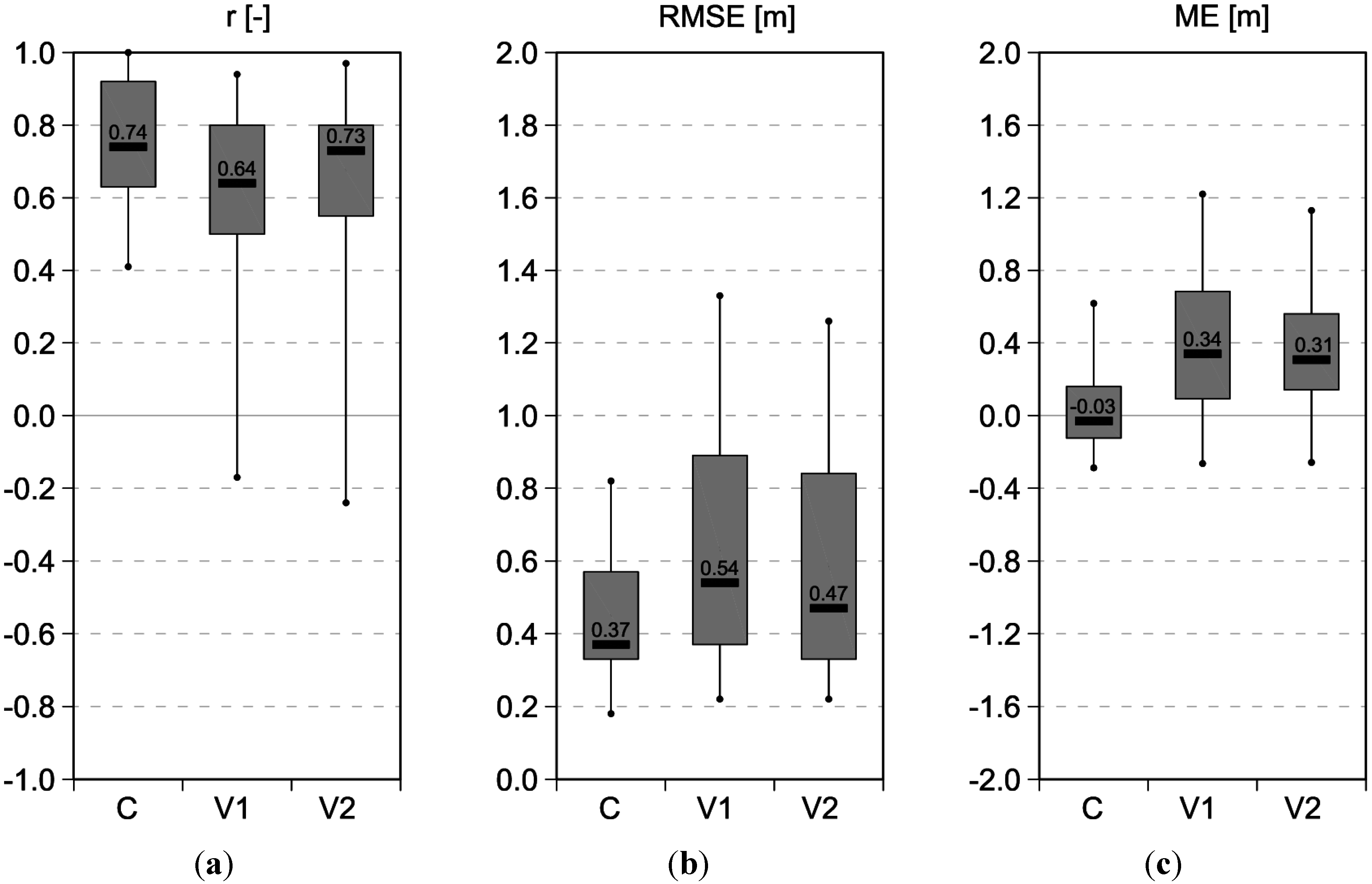
3. Results and Discussion
3.1. Groundwater Recharge

3.2. Interaction between Agricultural Areas and Tugai Forests
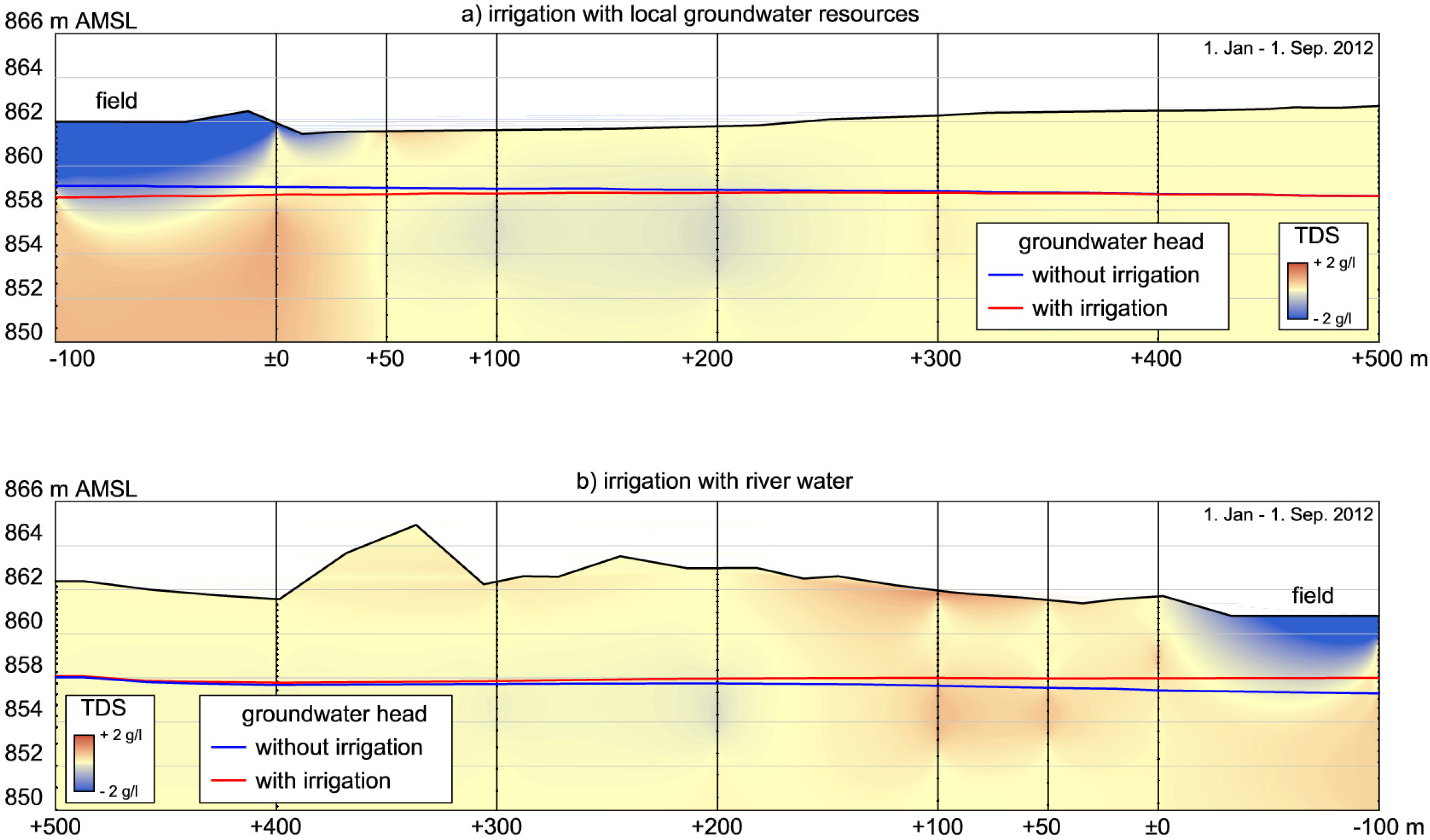
- -
- Agricultural areas should not be located in floodplains, because they adversely affect the extent of flooding.
- -
- Agricultural areas should be integrated with natural vegetation and not the other way around. The Tugai forests can benefit from the presence of small, but not connected, irrigation areas.
- -
- Using a combined water management strategy for managing the ground and surface water, negative impacts to the ecosystem can be reduced. If, for example, groundwater is used for irrigation in summer, the aquifer can be filled-up by leaching the fields with river water.
- -
- Drainage systems can reduce the salinization at agricultural areas with high natural groundwater tables.
3.3. Scenarios
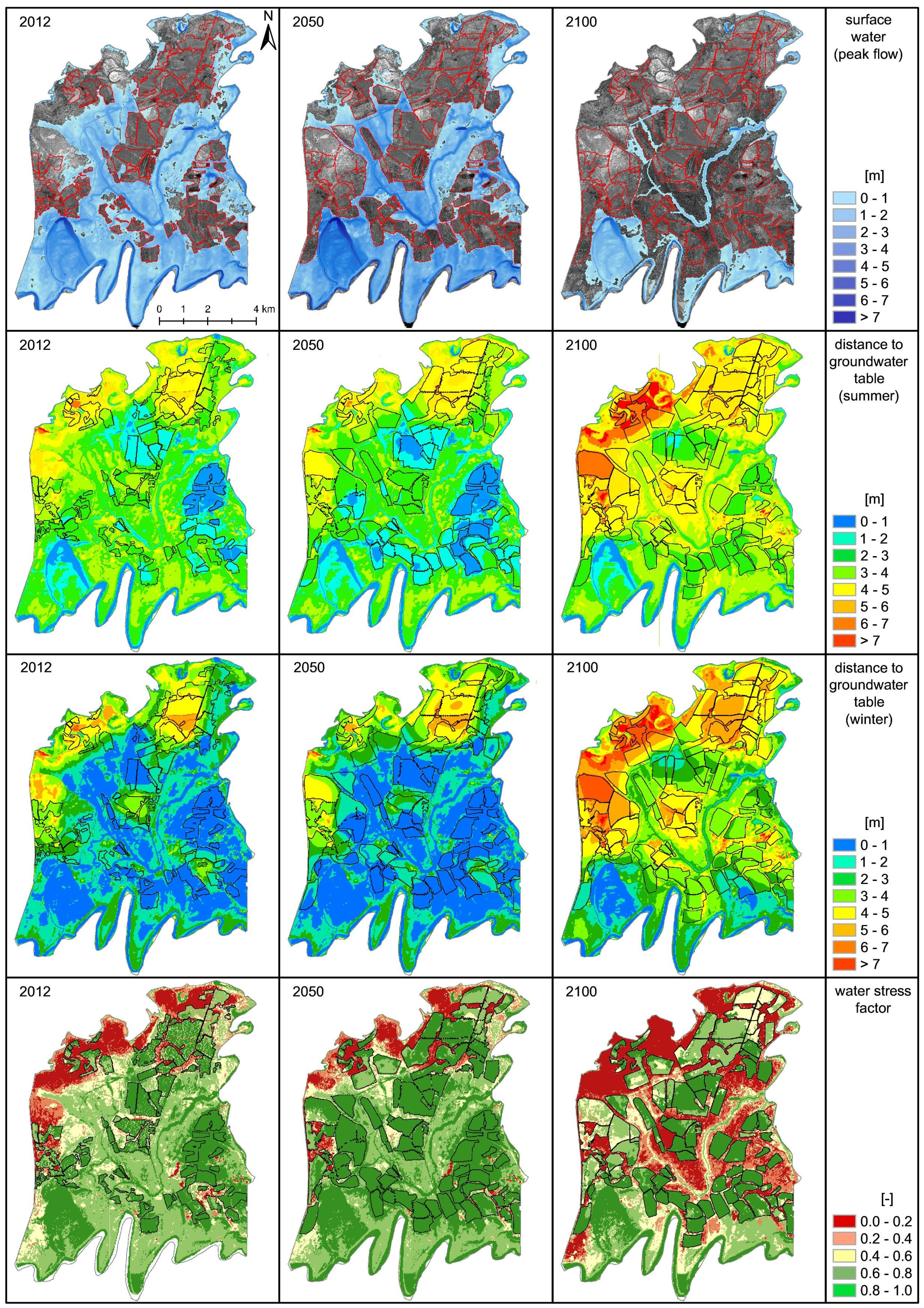
| Year | Area km2 | Land-Use | Land-Use and Climate Change | ||||
|---|---|---|---|---|---|---|---|
| Recharge million m3 | Recharge mm/a | Recharge Test Site mm/a | Recharge Million m3 | Recharge mm/a | Recharge Test Site mm/a | ||
| 2004 | natural = 75.3 | 10.8 | 143.4 | 124.4 | 10.8 | 143.4 | 124.2 |
| agricultural = 8.1 | −0.4 | −49.4 | −0.4 | −49.4 | |||
| Tarim = 1.9 | 0.2 | 105.3 | 0.2 | 105.3 | |||
| 2012 | natural = 64.1 | 9.8 | 152.1 | 116.2 | 9.8 | 152.1 | 116.2 |
| agricultural = 19.3 | 0.0 | 0.9 | 0.0 | 0.9 | |||
| Tarim = 1.9 | 0.1 | 76.3 | 0.1 | 76.3 | |||
| 2050 | natural = 51.2 | 7.2 | 140.2 | 103.3 | 7.8 | 152.3 | 116.8 |
| agricultural = 32.2 | 1.5 | 47.8 | 2.3 | 70.2 | |||
| Tarim = 1.9 | 0.1 | 49.0 | −0.1 | −52.6 | |||
| 2100 | natural = 48.9 | 7.2 | 148.1 | 95.8 | 3.2 | 65.8 | 68.6 |
| agricultural = 34.5 | 0.9 | 25.7 | 1.5 | 44.2 | |||
| Tarim = 1.9 | 0.1 | 26.4 | 1.1 | 584.5 | |||
| Year (Irrigation Area) | Land-Use Change | Land-Use and Climate Change | ||||||
|---|---|---|---|---|---|---|---|---|
| SW Million m3 | GW Million m3 | ∑ Million m3 | GW/SW % | SW Million m3 | GW Million m3 | ∑ Million m3 | GW/SW % | |
| 2004 (8.1 km2) | 2.64 | 1.39 | 4.03 | 52.6 | 2.64 | 1.39 | 4.03 | 52.6 |
| 2012 (19.3 km2) | 6.87 | 3.50 | 10.37 | 50.9 | 6.87 | 3.50 | 10.37 | 50.9 |
| 2050 (32.2 km2) | 10.83 | 6.06 | 16.89 | 56.0 | 11.05 | 6.34 | 17.39 | 57.4 |
| 2100 (34.5 km2) | 11.65 | 6.13 | 17.78 | 53.0 | 12.89 | 4.10 | 16.99 | 31.8 |
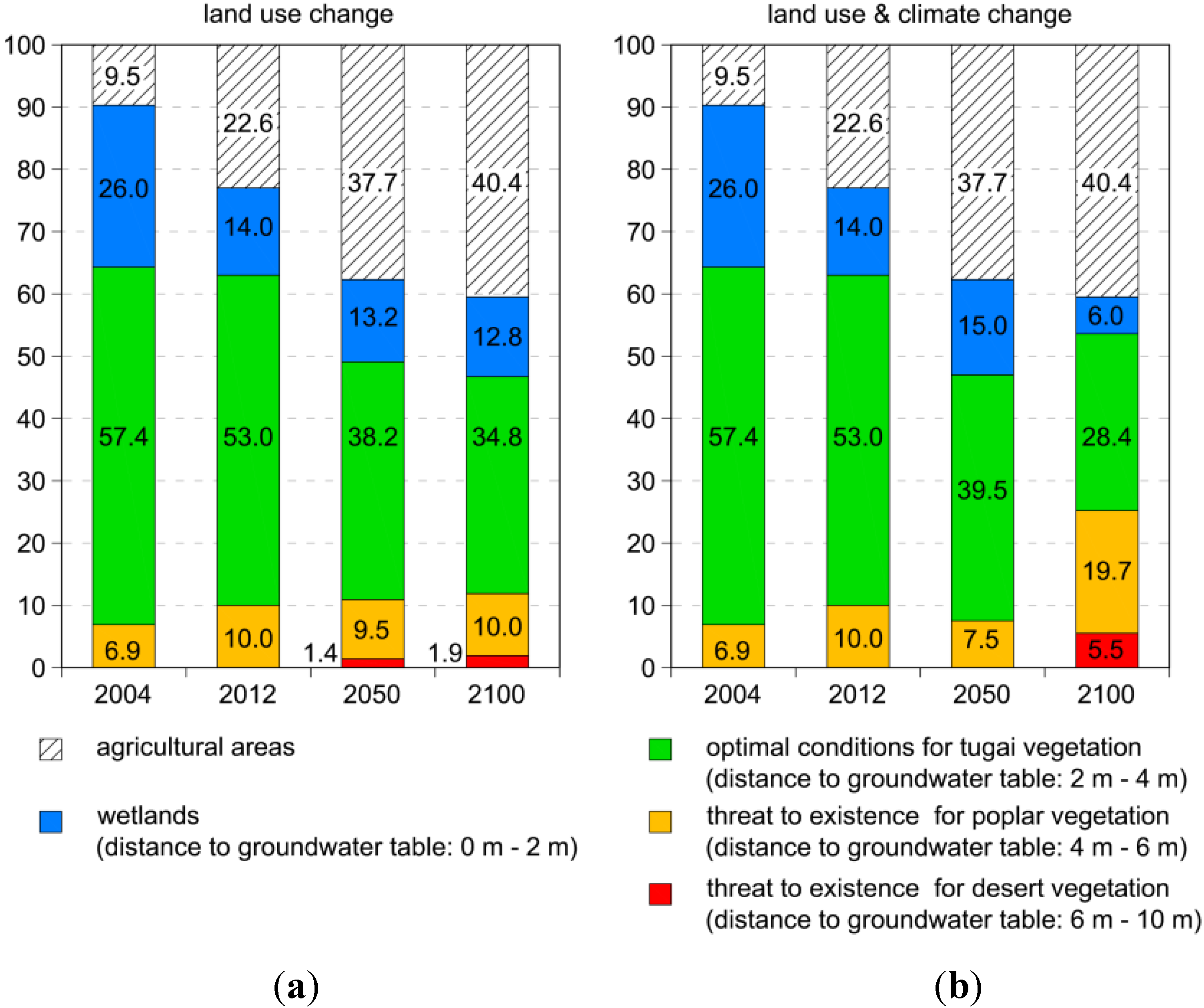
4. Conclusions
Acknowledgments
Author Contributions
Conflicts of Interest
References
- Tang, Q.; Hu, H.; Oki, T. Groundwater recharge and discharge in a hyperarid alluvial plain (Akesu, Taklimakan Desert, China). Hydrol. Process. 2007, 21, 1345–1353. [Google Scholar] [CrossRef]
- Halik, Ü.; Kurban, A.; Mijit, M.; Schulz, J.; Paproth, F.; Coenradie, B. The potential influence of embankment engineering and ecological water transfers on the riparian vegetation along the middle and lower reaches of the Tarim River. In Watershed and Floodplain Management along the Tarim River in China’s Arid Northwest; Shaker Verlag: Aachen, Germany, 2006; pp. 221–236. [Google Scholar]
- Aishan, T.; Halik, Ü.; Cyffka, B.; Kubab, M.; Abliza, A.; Baidourela, A. Monitoring the hydrological and ecological response to water diversion in the lower reaches of the Tarim River, Northwest China. Quat. Int. 2013, 311, 155–162. [Google Scholar] [CrossRef]
- Halik, Ü.; Chai, Z.; Kurban, A.; Cyffka, B.; Wei, R. The positive response of some ecological indices of Populus euphratica to the emergency water transfer in the lower reaches of the Tarim River. J. Rescour. Sci. 2009, 31, 1309–1314. (In Chinese) [Google Scholar]
- Aishan, T.; Halik, Ü.; Kurban, A.; Cyffka, B.; Kuba, M.; Betz, F.; Keyimu, M. Eco-Morphological response of floodplain forests (Populus euphratica Oliv.) to water diversion in the lower Tarim River, northwest China. Environ. Earth Sci. 2015, 73, 533–545. [Google Scholar] [CrossRef]
- Yang, B.; Brauning, A.; Zhang, Z.; Dong, Z.; Esper, J. Dust storm frequency and its relation to climate changes in Northern China during the past 1000 years. Atmos. Environ. 2007, 41, 9288–9299. [Google Scholar] [CrossRef]
- Rumbaur, C.; Thevs, N.; Disse, M.; Ahlheim, M.; Brieden, A.; Cyffka, B.; Duethmann, D.; Feike, T.; Frör, O.; Gärtner, P.; et al. Sustainable management of river oases along the Tarim River (SuMaRiO) in Northwest China under conditions of climate change. Earth Syst. Dyn. 2015, 6, 83–107. [Google Scholar] [CrossRef]
- Liu, Y.; Chen, Y. Impact of population growth and land-use change on water resources and ecosystems of the arid Tarim River Basin in Western China. Int. J. Sustain. Dev. World Ecol. 2006, 13, 1–11. [Google Scholar] [CrossRef]
- Glazirin, G.E. A century of investigations on outbursts of the ice-dammed lake Merzbacher (Central Tian Shan). Aust. J. Earth Sci. 2010, 103, 171–179. [Google Scholar]
- Sorg, A.; Bolch, T.; Stoffel, M.; Solomina, O.; Beniston, M. Climate change impacts on glaciers and runoff in Tien Shan (Central Asia). Nat. Clim. Chang. 2012, 2, 725–731. [Google Scholar] [CrossRef]
- Pang, Z.; Huang, T.; Chen, Y. Diminished groundwater recharge and circulation relative to degrading riparian vegetation in the middle Tarim River, Xinjiang Uygur, Western China. Hydrol. Process. 2010, 24, 147–159. [Google Scholar] [CrossRef]
- Tang, J.N.; Su, Z.Z.; Ding, F.; Zhu, S.J.; E, Y.H.; Zhai, X.W.; Yi, Z.Y.; Liu, H.J.; Zhang, J.C.; Li, F.M. The formation age and evolution of Kumtagh Desert. J. Arid Land 2011, 3, 114–122. [Google Scholar] [CrossRef]
- Luo, C.; Peng, Z.C.; Yang, D.; Liu, W.G.; Zhang, Z.F.; He, J.F.; Chou, C.L. A lacustrine record from Lop Nur, Xinjiang, China: Implications for paleoclimate change during Late Pleistocene. J. Asian Earth Sci. 2009, 34, 38–45. [Google Scholar]
- Chen, Y.; Xu, C.; Hao, X.; Li, W.; Chen, Y.; Zhu, C.; Ye, Z. Fifty-Year climate change and its effect on annual runoff in the Tarim River Basin, China. Quat. Int. 2009, 208, 53–61. [Google Scholar]
- Statistisches Jahrbuch Xinjiang 1978–2010. China Statistical Press, 2013. Available online: http://www.xjtj.gov.cn/sjcx/tjnj_3415/ (accessed on 16 June 2015). (In Chinese)
- Digital Globe. 2013. Available online: www.digitalglobe.com (accessed on 08 October 2013).
- Gstaiger, V.; Huth, J.; Gebhardtb, S.; Wehrmanna, T.; Kuenzera, C. Multi-Sensoral and automated derivation of inundated areas using TerraSAR-X and ENVISAT ASAR data. Int. J. Remote Sens. 2012, 33, 7291–7304. [Google Scholar] [CrossRef]
- Keilholz, P. Auswirkungen von veränderter Landnutzung auf den Wasserhaushalt und die Auwaldvitalität in einer Flussoase am Tarim (China). Ph.D. Thesis, Technische Universität München, Munich, Germany, 2014. [Google Scholar]
- National Aeronautics and Space Administration (NASA). Available online: http://trmm.gsfc.nasa.gov/data_dir/data.html (accessed on 28 January 2014).
- Penman, H. Estimating evaporation. Trans. Am. Geophys. Union 1956, 37, 43–46. [Google Scholar] [CrossRef]
- Monteith, J.L. Evaporation and surface temperature. Q. J. R. Meteorol. Soc. 1981, 107, 1–27. [Google Scholar] [CrossRef]
- Thevs, N. Ecology, Spatial Distribution, and Utilization of the tugai Vegetation at the Middle Reaches of the Tarim River, Xinjiang, China. Ph.D. Thesis, Ernst-Moritz-Arndt-Universität Greifswald, Greifswald, Germany, 2006. [Google Scholar]
- Thevs, N.; Ahemaitijiang, R.; Nuerbayi, A. Evapotranspiration of riparian ecosystems and irrigated land anlong the middle reaches of the Tarim River, Xinjiang, China. Agric. For. Meteorol. 2013. submitted. [Google Scholar]
- Canadell, J.; Jackson, R.B.; Ehleringer, J.B.; Mooney, H.A.; Sala, O.E.; Schulze, E.-D. Maximum rooting depth of vegetation types at the globale scale. Oecologia 1996, 108, 583–595. [Google Scholar] [CrossRef]
- Thomasa, F.M.; Foetzkia, A.; Arndtb, S.K.; Bruelheidea, H.; Griesa, D.; Lic, X.; Zengc, F.; Zhangc, X.; Rungea, M. Water use by perennial plants in the transition zone between river oasis and desert in NW China. Basic Appl. Ecol. 2006, 7, 253–267. [Google Scholar] [CrossRef]
- Khamzina, A.; Sommer, R.; Lamers, J.; Viek, P. Transpiration and early growth of tree plantations established on degraded cropland over shallow saline groundwater table in northwest Uzbekistan. Agric. For. Meteorol. 2009, 149, 1865–1874. [Google Scholar] [CrossRef]
- Parkinson, C.L.; Greenstone, R. EOS Data Products Handbook; National Aeronautics and Space Administration (NASA): Greenbelt, MD, USA, 2000; Volume 2. [Google Scholar]
- Zhao, C.; Yan, Y.; Yimamu, Y.; Li, J.Y.; Zhao, Z.M.; Wu, L.S. Effects of soil moisture on cotton root length density and yield under drip irrigation with plastic mulch in Aksu Oasis farmland. J. Arid Land 2010, 2, 243–249. [Google Scholar]
- DHI Water & Environment. MIKE SHE User Manual, Volume 1: User Guide; DHI Water & Environment: Hørsholm, Denmark, 2007. [Google Scholar]
- Liu, H.-L.; Chen, X.; Wang, L. Investigation of groundwater response to overland flow and topography using a coupled MIKE SHE/ MIKE 11 modeling system for an arid watershed. J. Hydrol. 2007, 347, 448–459. [Google Scholar] [CrossRef]
- Kirstensen, K.; Jensen, S. A model for estimating actual evapotranspiration from potential evapotranspiration. Nord. Hydrol. 1975, 6, 170–188. [Google Scholar]
- Richards, L. Capillary conduction of liquids through porous mediums. J. Appl. Phys. 1931, 1, 318–333. [Google Scholar] [CrossRef]
- Van Genuchten, M.T. A Closed-Form equation for predicting the hydraulic conductivity of unsaturated soils. Soil Sci. Soc. Am. J. 1980, 44, 892–898. [Google Scholar] [CrossRef]
- Mualem, Y. A new model for predicting the hydraulic conductivity of unsaturated porous media. Water Resour. Res. 1976, 12, 513–522. [Google Scholar] [CrossRef]
- Twarakavi, N.K.C.; Simunek, J.; Schaap, M.G. Can texture-based classification optimally classify soils with respect to soil hydraulics? Water Resour. Res. 2010, 46, 1–11. [Google Scholar] [CrossRef]
- Schaap, M.; Leij, F.; van Genuchten, M.T. ROSETTA: A computer program for estimating soil hydraulic parameters with hierarchical pedotransfer functions. J. Hydrol. 2001, 251, 163–176. [Google Scholar] [CrossRef]
- MIKE SHE setup. Available online: http://www.sumario.de/docs (accessed on 12 June 2015).
- Intergovernmental Panel on Climate Change (IPCC). Climate Change 2013: The Physical Science Basis. Contribution of Working Group I to the Fifth Assessment Report of the Intergovernmental Panel on Climate Change; Cambridge University Press: New York, NY, USA, 2013. [Google Scholar]
- Aishan, T.; Halik, Ü.; Betz, F.; Tiyip, T.; Ding, J.; Nuermaimaiti, Y. Stand structure and height-diameter relationship of a degraded Populus euphratica forest in the lower reaches of the Tarim River, Northwest China. J. Arid Land 2015, 7, 544–554. [Google Scholar] [CrossRef]
© 2015 by the authors; licensee MDPI, Basel, Switzerland. This article is an open access article distributed under the terms and conditions of the Creative Commons Attribution license (http://creativecommons.org/licenses/by/4.0/).
Share and Cite
Keilholz, P.; Disse, M.; Halik, Ü. Effects of Land Use and Climate Change on Groundwater and Ecosystems at the Middle Reaches of the Tarim River Using the MIKE SHE Integrated Hydrological Model. Water 2015, 7, 3040-3056. https://doi.org/10.3390/w7063040
Keilholz P, Disse M, Halik Ü. Effects of Land Use and Climate Change on Groundwater and Ecosystems at the Middle Reaches of the Tarim River Using the MIKE SHE Integrated Hydrological Model. Water. 2015; 7(6):3040-3056. https://doi.org/10.3390/w7063040
Chicago/Turabian StyleKeilholz, Patrick, Markus Disse, and Ümüt Halik. 2015. "Effects of Land Use and Climate Change on Groundwater and Ecosystems at the Middle Reaches of the Tarim River Using the MIKE SHE Integrated Hydrological Model" Water 7, no. 6: 3040-3056. https://doi.org/10.3390/w7063040
APA StyleKeilholz, P., Disse, M., & Halik, Ü. (2015). Effects of Land Use and Climate Change on Groundwater and Ecosystems at the Middle Reaches of the Tarim River Using the MIKE SHE Integrated Hydrological Model. Water, 7(6), 3040-3056. https://doi.org/10.3390/w7063040







